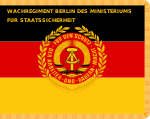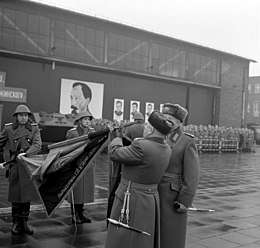Felix Dzerzhinsky Guards Regiment
The Felix Dzerzhinsky Guards Regiment (German: Wachregiment "Feliks E. Dzierzynski") was the paramilitary wing of the Ministry for State Security (Stasi), the security service of the German Democratic Republic (GDR).
| Felix Dzerzhinsky Guards Regiment | |
|---|---|
| Wachregiment "Feliks E. Dzierzynski" | |
 Felix Dzerzhinsky Guards Regiment insignia | |
| Active | November 1954 – 2 October 1990 |
| Country | |
| Branch | Ministry for State Security |
| Type | Infantry |
| Role | Motorized infantry |
| Size | 11,426 (1989) |
| Garrison/HQ | Adlershof, East Berlin |
| March | Präsentiermarsch des Wachregiment "Feliks Dzierzynski" |
| Insignia | |
| Regimental flag |  |
| Cuffband | |
The Felix Dzerzhinsky Guards Regiment was called a regiment, however the elite formation gradually grew to the size of a motorized infantry division with its constituent Kommandos made up of battalions. Its role in the Stasi was the protection of buildings and high-ranking officials of the GDR government and the Socialist Unity Party of Germany. It was composed of experienced and ideologically reliable men separate from the National People's Army that could be deployed to suppress rebellion and unrest.[1]
History
The Guards Battalion A at the MfS (Wachbataillon A beim MfS) was founded in early 1951 as an armed force to complement the Ministry for State Security (MfS or Stasi), the security service of the German Democratic Republic (GDR), the de facto communist state established on 7 October 1949 from the Soviet Zone of Occupation. The GDR was ruled by the Socialist Unity Party of Germany (SED) under significant Soviet influence, but despite authoritarian measures to suppress the political opposition, threats of instability remained. The SED followed the Soviet model of creating a dedicated elite and politically allegiant armed force to protect itself. The Guards Battalion A participated in the suppression of the Uprising of 1953 against the SED's Stalinization policies. In November 1954, the Guards Battalion A was set up as the official paramilitary wing of the Stasi and its staff headquartered in Adlershof, East Berlin. In August 1961, units of the Guards Battalion A participated in the construction of the Berlin Wall. In 1967, the Guards Battalion A was officially renamed the Felix Dzerzhinsky Guards Regiment (Wachregiment "Feliks E. Dzierzynski") in honor of Felix Dzerzhinsky, founder of the Cheka.
The Felix Dzerzhinsky Guards Regiment's major task was the protection of the SED, especially its buildings in the capital of East Berlin, and from 1960 providing security for the party leaders' private residential compound, Waldsiedlung, located 24 kilometres (15 mi) north of Berlin near Wandlitz.
The Stasi was dissolved on 13 January 1990 and its facilities and responsibilities taken over by the GDR's Ministry of the Interior (Ministerium des Innern) but the regiment continued to exist. The Felix Dzerzhinsky Guards Regiment was formally dissolved on 2 October 1990, the day before the GDR was dissolved in the German reunification.
Organization
- Personnel: At full strength, the regiment consisted of over 11,200 personnel, including 2,500 officers, 8,735 NCOs and enlisted men, and nine civil staff. Its commander was a Major General after 1956.
- Subunits: It comprised the following:
- Three combat groups with six motorized rifle battalions and three training battalions,
- an artillery battalion and
- engineer, medical, support and reconnaissance companies.
The Regiment was subdivided into the following commands from 1980 to 1989:
- Kommando 1 – Standort Adlershof, Standorte in den Bezirken Command 1 - Location Adlershof, locations in the districts
- Kommando 2 – Standort Erkner - Erkner
- Kommando 3 – Standort Teupitz - Teupitz
- Kommando 4 – Standort in Eberswalde-Finow later (mid 1980s) in Erkner, Prenden and Biesenthal
- Kommando 5 – Standort Berlin until 1982, then Freienbrink Ahrensfelde
The sites were inherited by the Ahrensfelde guard regiment in mid-January 1989. Until then they had formed accommodation facilities for UAV units of the Ministry for State Security (e.g., backup units of VRD, BDL, HA VI, AGMS). These units were the uniformed as well as the guard and security units of the units of the Stasi (BV), not a subdivision of the guards regiment. Part of these units were merged in January 1989 into the guard regiment, which is why the site was taken over by the Ahrensfelde guard regiment. Until 1989, the guard regiment had no locations in the districts. The service objects there were guarded by the WSE, which were placed under the respective BV.
Personnel Strength
The personnel strength of the regiment:
- 1955: 1.475
- 1960: 4.372
- 1965: 5,121
- 1970: 7,924
- 1975: 9,245
- 1980: 10,082
- 1985: 10,192
- 1989: 11,426
Senior Management
Commanders of the guards regiment were:
- 1962 to 1972: Major-General Heinz Gronau (provisional)
- 1972 to 1987: Colonel (Major General since 1976) Bernhard Elsner
- 1987 to 1990: Major-General Manfred Döring
Recruitment and training
Military service in the Guard regiment was completed as WED (abbr. Wehrersatzdienst, alternative military service). The term of service for conscripts was three years. In contrast to the National People's Army, recruits were inducted in April and September / October, a month earlier.
Recruits were selected from particularly politically reliable families and the express wishes of the conscripts only played a role in some cases.
Many conscripts in Adlershof traditionally decorated the fence of the building next door to them (Deutscher Fernsehfunk; East German TV broadcasting) with the padlocks from their lockers when they were dismissed. These locks were removed every year.
Equipment
It received the same training and equipment as the Volkspolizei-Bereitschaft and some of its personnel were paratroopers. It was also equipped with modern armored fighting vehicles and armored personnel carriers, anti-tank guns, anti-aircraft weapons and mortars.
The guard regiment was equipped with small arms (Makarov, Walther PP, PM-63 RAK, AKM, AK-74, LMG, RPG-7) to light armored personnel carriers (SPW 60 PB, SPW, 70, PSH).
Stationed in the command 3 (on military Teupitz - cones), there was also a battalion of special weapons. It consisted of a company, which was armed with heavy anti-tank recoilless gun SPG-9 (in 1987, was reorganized into a rifle company), a company which is an essential weapon, the heavy machine gun (HMG-company) and had the 70mm - anti-aircraft missile armed "Strela-2 'Company. Until 1982 there was also an artillery detachment armed with 122mm D-30 howitzer. Previously they had 85-mm PaK D-44, and 82mm mortars and 120 mm in the stock.
Regulators company RSK was additionally can be equipped with the AKS74 around the shoulder stock to collapse. At least in the 1970s, the former intelligence battalion, the mortar batteries and the I-battalion with Kalashnikovs in the S version were equipped. Specialized units such as the honor companies (28. and 29 MSK of the 10th MSB) were fitted in addition to the above-mentioned weapons, rifles and sabers.
The paratrooper company, located in the reconnaissance battalion also used the small Skorpion machine pistol from Czechoslovakia.
For large events, there were as accessories batons (flexible), down from 1989 shields and helmets and chains.
Transportation
Personnel transport were mainly prepared by W50 and the Ural trucks. In line with this design the vehicles of the army, however, bore the registration plates of the People's Police, with the letters stacked VP. When events were Ikarus buses used.
Uniforms


Its uniforms were nearly identical to those of the National People's Army (NVA) and were distinguished primarily by the dark red MfS service color of its insignia and by a cuff title on the left sleeve bearing the regiment's name. Other Stasi officers wore a similar uniform, but without the cuffband. Members were selected from among the most reliable volunteer recruits and had to perform a three-year minimum service tour.[1]
The service or dress uniform of the regiment was an army uniform made of high quality (of officers) with claret fabric collar and brown (officer) leather belt. The left sleeve was fitted with a cuffband and the words "wachregiment F. Dzerzhinsky".
Soldiers of the MOS units typically had the following personal uniforms:
- 1x service uniform (cap, tunic, trousers Parade (breeches), gray shirt, tie, officer boots grained, brown belt)
- 1x semi-dress uniform (cap, tunic, output pants, gray shirt, tie, shoes, brown belt)
- 1x summer field service uniform ( "Ein Strich - Kein Strich" ("one dash - no dash") Steel Helmet ( "eggshell") / cap, gray Gurtkoppel, officer boots grained)
- 1x Field Service Uniform Winter ("Ein Strich - Kein Strich")
- 1x special service uniform – tunic, parade trousers (breeches), gray shirt, tie, an officer in plain boots, belts, NCO Professional version (with at least Corporal epaulets, even if the soldier in question was only temporary soldiers and rank only a soldier) (not in the personal cabinet)
- 1x Drillich (Arbeitsuniform) fatigues (work uniform)
- 1x Winter Service Uniform
- 1x sport suit "SV Dynamo" in burgundy, white sneakers
In command 4 - Eberswalde-Finow in Bernau contributed UAZ, professional officers and professional officers uniforms of the regular army with weapons Color black (pioneers) and (white Motorized Rifle) to camouflage the Wachregimentseinsatzes. The UAZ wore the army uniform from the rough cloth.
Other guard units
The regiment was one of three guards regiments in the GDR. The other two were units of the regular army:
- 1. Wachregiment "Friedrich Engels" (WR-1) guarded the Memorial to the Victims of Fascism and Militarism on Berlin's Unter den Linden and performed other honorary duties, including the welcoming ceremony for state visitors.
- 2. Wachregiment "Hugo Eberlein" (WR-2) guarded the Ministry for National Defense command center in Strausberg, near Berlin.
See also
- Wachbataillon - the West German equivalent.
- PM-63 RAK - PDW type weapon in use with the Regiment.
References
- Forester, Thomas M., The East German Army; Second in the Warsaw Pact, George Allen & Unwin Ltd, London, 1980
- Hagen Koch, Peter Joachim Lapp: Die Garde des Erich Mielke - Der militärisch-operative Arm des MfS - Das Berliner Wachregiment "Feliks Dzierzynski", Helios-Verlag Aachen 2008, ISBN 978-3-938208-72-4
- Pickard, Ralph (2007). STASI Decorations and Memorabilia, A Collector's Guide. Frontline Historical Publishing. ISBN 978-0-9797199-0-5.
- Pickard, Ralph (2012). STASI Decorations and Memorabilia Volume II. Frontline Historical Publishing. ISBN 978-0-9797199-2-9.